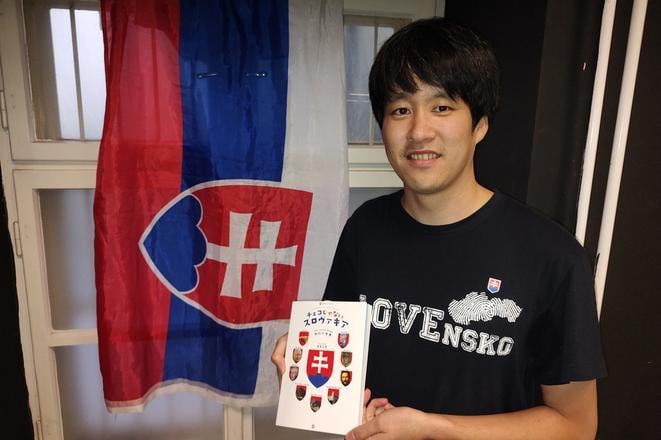Shogo Mashine moved to Slovakia from Tokyo, Japan, nine years ago to write a research paper on wine growing in Slovakia’s Small Carpathian region. He wound up learning Slovak and working in the Embassy of Japan to the Slovak Republic as a researcher. After moving back to Japan, he began work on a book designed to educate Japanese people about Slovakia, called Slovensko, nie Česko (Slovakia, not Czechia! in English). The book, written almost entirely in Japanese, contains over 200 pages of information on Slovakia, over eight chapters ranging from the differences between Slovakia and Czechia, the natural beauty of Slovakia, its many castles, famous and influential Slovaks and much more. Shogo is now living back in Tokyo, this time working for the Embassy of Slovakia to Japan.
Shogo sat down with the Slovak Spectator to go into what brought him to Slovakia, his thoughts on what Slovaks and Japanese people have in common and a Slovak restaurant in Kobe.
Congratulations on the book. Can you tell me about how it is being received?
This edition is about 1500 copies, and they already sold more than half. We had a release party for the book in the Slovak embassy in Japan and it’s been really well received, I really appreciate it.
Can you tell me about the title, what was the inspiration?
Well, it’s “Slovensko, nie Česko”, because most Japanese people only know about Czechia.
What would the typical Japanese person know about Slovakia, or central Europe in general?
It's seen as like a romantic country, all the cities are beautiful and things like classical music, many castles. Now it's getting known among the people as a former communist country. There are many aspects.
What about you? When did you come to Slovakia?
The first time I came to Slovakia to meet with my friend who studied in Tokyo. I came in 2010, just for two days. I was travelling around Europe. I was interested in it after my visit though. At that time, I studied the geography of Europe, so I wanted to choose one country to write my thesis on. Japanese people know Europe as places like France, Germany, Spain, the UK, but not so much central Europe or eastern Europe.
I thought this is a really interesting country because it's located in the centre of the continent, and it has two faces, something western and eastern. I was very lucky to find a Japanese professor who studies Slovakia. He speaks Slovak perfectly, and that kicked off my learning the language.
What was the professor lecturing in?
He was lecturing Central European studies in general, but sometimes he had a special lecture focused on Slovakia, like about Milan Rastislav Štefánik (Slovak statesman - ed.).
People are learning about Štefánik in Japan?
It's really interesting, Štefánik stayed in Japan for one month when he came on a diplomatic mission to ask the Japanese government to send more soldiers to Siberia to save the Czechoslovak legion, during World War I. So Štefánik met with both the emperor and prime minister of Japan.
Who is Milan Rastislav Štefánik?
M. R. Štefánik was a key figure in Czechoslovak independence in the early 20th century, and was involved with the efforts to establish an independent Czechoslovak republic during WWI. He died in a plane crash in 1919, and Bratislava’s airport is named after him.
So you came to Slovakia the first time in 2010, then you studied about it in college. And then...
Yes, and also I studied one year in Slovakia from 2014 to 2015 to do my own research about geography. I wrote my thesis about the Slovak wine industry in Malé Karpaty, the Small Carpathian region. And how small winemakers compete with big companies like Matyšák and such. Because there are so many small family winemakers and some of them have already been successful. They are making unique wines and trying to welcome more tourists from the rest of Europe. I wrote my thesis in Japanese, but I needed to come here to take a survey, so I studied here for one year.
Did you drink a lot of wine?
(Laughing) Yeah, a lot of wine, yes. But also I picked grapes, attended fairs and festivals and examined the whole winemaking process.
How did that lead to you working in the embassy here?


